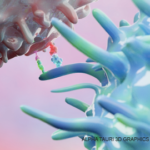Chronic lung disease is characterized by repeated cycles of injury. The repetitive damage to the airway or alveolar epithelium is a common feature of idiopathic pulmonary fibrosis, chronic obstructive pulmonary disease (COPD), asthma, and bronchiolitis obliterans syndrome (BOS). Not only is epithelial injury common in chronic inflammatory lung diseases, but both alloimmune and nonalloimmune insults to the airway epithelium are associated with an increased incidence of BOS after lung transplantation.
Previous studies have suggested that fibroblasts from chronically inflamed tissues show alteration in inflammatory gene expression when compared to fibroblasts from normal tissues. Monika Suwara, a graduate student in Newcastle University in the United Kingdom, and colleagues address the role of fibroblasts in chronic lung disease in a study published in Mucosal Immunology.1
The investigators describe an interleukin (IL) 1α and double-stranded RNA signaling network that triggers a powerful proinflammatory phenotype in lung fibroblasts. The resulting activated fibroblasts have a pattern recognition receptor expression profile that is distinct from that produced by alveolar macrophages.
The team performed their initial experiments using human bronchial epithelial cells that were pulsed with either thapsigargin to induce endoplasmic reticulum (ER) stress or H2O2 to induce oxidative stress. The stressed cells released a damage-associated molecular pattern that was dominated by IL-1α.
Based upon these data, the investigators hypothesized that IL-1α/IL-1 receptor signaling was required for the stimulation of an inflammatory fibroblast phenotype. To test the hypothesis, they treated primary human lung fibroblasts (PHLF) with increasing doses of IL-1α and analyzed the conditioned media from the cells for the presence IL-8. They found that treatment with IL-1α significantly increased the release of IL-8 from PHLFs.
The investigators then used polycytidylic acid as a surrogate for viral RNA. PHLFs had a moderate response to polycytidylic acid. A combined treatment with poly polycytidylic acid and IL-1α resulted in even greater IL-6 and IL-8 gene expression and protein production by the fibroblasts. The investigators then examined transgenic mice that lacked either the IL-1 receptor or IL-1α and treated them with bleomycin. Bleomycin induces significant levels of oxidative stress in lung epithelial cells of normal mice. They found that the transgenic mice had reduced bronchoalveolar lavage (BAL) neutrophilia and collagen deposition in response to bleomycin treatment.
“The bottom line is that sterile airway epithelial injury causes release of IL-1α, which acts as an alarmin to cause lung fibroblasts to develop a potent proinflammatory phenotype. Our in-vivo model suggests that IL-1α plays an important role in driving the neutrophilic inflammatory response to a sterile insult to the lung and its absence ameliorates the neutrophilia and subsequent fibrogenesis. This raises the possibility that IL-1α may be a target to limit chronic lung inflammation and fibrogenesis,” wrote senior author Andrew J. Fisher BMedSci, PhD, also of Newcastle University, to The Rheumatologist.
